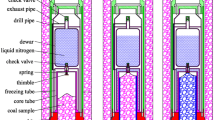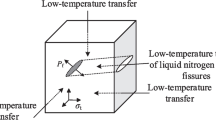Abstract
To estimate accurately the coalbed methane content, a pressurized sampling method with the aid of frozen sealing is proposed. In addition, the influences of adsorption gas pressure, freezing temperature, soaking time in drilling fluid, drilling fluid type, and exposure time in the atmosphere on the gas loss rate and the gas desorption characteristics of frozen samples were evaluated. Under low gas pressure, the gas in adsorption and free state in the coal sample can be trapped completely by the freezing sampling method. However, an appropriate freezing temperature is necessary to limit gas loss caused by frost cracks. The addition of polymers to the drilling fluid can enhance gas solubility and improve the gas trap capacity of the freezing sampling method. Although the freezing method can seal the gas perfectly in a coal sample, gas loss caused by gas diffusion through the frozen body is still difficult to avoid. Therefore, reducing the sampling time can limit effectively the gas loss rate. The freezing sampling method was confirmed to be an efficient method for obtaining gas-containing geological samples in an in situ state. The gas loss characteristics of coalbed coal sampled using the freezing method can provide theoretical support for reducing and estimating gas loss during the freezing sampling process.










Similar content being viewed by others
References
Akyurt, M., Aljawi, A., & Aldousari, S. (2005). Ice-based technique for burst testing of tubular elements. Journal of King Abdulaziz University-Engineering Sciences, 16(1), 103–130.
Ali, A., Alves, T. M., Saad, F. A., Ullah, M., Toqeer, M., & Hussain, M. (2018). Resource potential of gas reservoirs in South Pakistan and adjacent Indian subcontinent revealed by post-stack inversion techniques. Journal of Natural Gas Science and Engineering, 49, 41–55.
Bertard, C., Bruyet, B., & Gunther, J. (1970). Determination of desorbable gas concentration of coal (direct method). International Journal of Rock Mechanics and Mining Science & Geomechanics, 7(1), 43–65.
Bowen, R. J., Keary, A. C., & Syngellakis (1996). Pipe freezing operations offshore: Some safety considerations. In International conference on offshore mechanics arctic engineering (OMAE), Florence (Italy).
Clayton, J. L. (1998). Geochemistry of coalbed gas: A review. International Journal of Coal Geology, 35(1–4), 159–173.
Diamond, W. P., & Schatzel, S. J. (1998). Measuring the gas content of coal: A review. International Journal of Coal Geology, 35(1–4), 311–331.
Dickens, G. R., Castillo, M. M., & Walker, J. (1997). A blast of gas in the latest Paleocene: Simulating first-order effects of massive dissociation of oceanic methane hydrate. Geology, 25(3), 259–262.
Flores, R. M. (1998). Coalbed methane: From hazard to resource. International Journal of Coal Geology, 35(1–4), 3–26.
Flores, R. M. (2014). Resource evaluation methodologies. Coal and Coalbed Gas, 6, 301–368. https://doi.org/10.1016/B978-0-12-396972-9.00006-9
Freire-Lista, D. M., Fort, R., & Varas-Muriel, M. J. (2015). Freeze-thaw fracturing in building granites. Cold Regions Science Technology, 113, 40–51.
Haiqi, Z., Shengxiong, Y., Nengyou, W., Xin, S., & Gary, H. (2007). Successful and surprising results for China's first gas hydrate drilling expedition. Fire in the ice. Fall 2007.
Hao, S., Yin, X., & Fang, J. (2021). Drilling technology for soft broken coal seam underground gas extraction in coalmines. Drilling Engineering, 48(S1), 173–180.
Hofmann, B. A., Sego, D. C., & Robertson, P. K. (2000). In situ ground freezing to obtain undisturbed samples of loose sand. Journal of Geotechnical and Geoenvironmental Engineering, 126(11), 979–989.
Hou, X., Liu, S., & Yang, Y. (2020). Evaluation of gas contents for a multi-seam deep coalbed methane reservoir and their geological controls: In situ direct method versus indirect method. Fuel, 265, 116917.
Huang, C., Xiong, Q., & Huang, Q. (2021). Coalfield wire-line drilling should be established as a new drilling system. Drilling Engineering, 48(9), 72–81.
Keary, A. C., & Bowen, R. J. (1999). On the prediction of local ice formation in pipes in the presence of natural convection. Journal of Heat Transfer, 121, 934–944.
Kim, A. G. (1977). Estimating methane content of bituminous coalbeds from adsorption data. Bureau of Mines.
Kubo, Y., Mizuguchi, Y., Inagaki, F., & Yamamoto, K. (2014). A new hybrid pressure-coring system for the drilling vessel chikyu. Scientific Drilling, 17(17), 37–43.
Kvenvolden, K. A., Barnard, L. A., & Cameron, D. H. (1983). Pressure core barrel: Application to the study of gas hydrates, deep sea drilling project site 533, Leg 76. U.S. Government Printing Office.
Li, L., Peng, J., Gao, Q., Sun, M., Liu, Y., Li, M., Chen, B., & Bo, K. (2016). Pressure retaining method based on phase change for coring of gas hydrate-bearing sediments in offshore drilling. Applied Thermal Engineering, 107, 633–641.
Li, X., Li, K., Wang, Z., Zhang, Y., Yin, H., & Shi, S. (2020). The story of a drilling weapon-pressure core sampler. Drilling Engineering, 47(7), 62–65.
Li, X., Ruan, H., Zhao, Y., Cai, J., Chen, Y., Liang, T., Li, C., Liu, H., & Deng, D. (2021). Progress in research and application of the pressure-temperature core sampler for marine natural gas hydrate. Drilling Engineering, 48(7), 33–39.
Liao, Z., Liu, X., Song, D., He, X., Nie, B., Yang, T., & Wang, L. (2020). Micro-structural damage to coal induced by liquid CO2 phase change fracturing. Natural Resources Research, 30, 1613–1627.
Liu, A., Fu, X., Wang, K., Hui, A., & Wang, G. (2013). Investigation of coalbed methane potential in low-rank coal reservoirs: Free and soluble gas contents. Fuel, 112, 14–22.
Luo, Y., Peng, J., Sun, M., Sun, Q., Ji, T., & Bo, K. (2015). An ice-valve-based pressure-coring system for sampling natural hydrate-bearing sediments: Proof-of-concept laboratory studies. Journal of Natural Gas Science and Engineering, 27(3), 1462–1469.
Matsumoto, R., Ryu, B., Lee, S., Lin, S., Wu, S., Sain, K., Pecher, I., & Riedel, M. (2011). Occurrence and exploration of gas hydrate in the marginal seas and continental margin of the Asia and Oceania region. Marine and Petroleum Geology, 28(10), 1751–1767.
Moore, T. A. (2012). Coalbed methane: A review. International Journal of Coal Geology, 101, 36–81.
Nazimko, V. (2018). A method for measuring coalbed methane content in coal strata without the loss of the gas. Acta Geodynamica et Geomaterialia, 15(4), 379–393.
Owen, L. B., & Sharer, J. (1992). Method calculates gas content per foot of coalbed methane pressure core. Oil & Gas Journal, 90(9), 47–49.
Ross, D. A., Neprochnov, Y. P., & Supko, P. R. (1978). Introduction and explanatory notes, Leg 42B, deep sea drilling project. Initial Reports of the Deep Sea Drilling Project. https://doi.org/10.2973/dsdp.proc.42-2.101.1978
Ruiz-Ruiz, P., Gómez-Borraz, T. L., Revah, S., & Morales, M. (2020). Methanotroph-microalgae co-culture for greenhouse gas mitigation: Effect of initial biomass ratio and methane concentration. Chemosphere, 259, 127418.
Ryu, B., Collett, T. S., Riedel, M., Kim, G. Y., Chun, J.-H., Bahk, J.-J., Lee, J. Y., Kim, J.-H., & Yoo, D.-G. (2013). Scientific results of the Second Gas Hydrate Drilling Expedition in the Ulleung Basin (UBGH2). Marine and Petroleum Geology, 47, 1–20.
Schultheiss, P. J., Francis, T., Holland, M., Roberts, J. A., Amann, H., & Thjunjoto. (2006). Pressure coring, logging and subsampling with the hyacinth system. Geological Society London Special Publications, 267(1), 151–163.
Schultheiss, P., Holland, M., & Humphrey, G. (2009). Wireline coring and analysis under pressure: Recent use and future developments of the hyacinth system. Scientific Drilling, 7, 44–50.
Stone, H. B. J., Martin, C. I., Richardson, R. N., & Bowen, R. J. (2004). Modelling of accelerated pipe freezing. Chemical Engineering Research and Design, 82(A10), 1353–1359.
Su, E., Liang, Y., Chang, X., Zou, Q., & Sasmito, A. P. (2020). Effects of cyclic saturation of supercritical CO2 on the pore structures and mechanical properties of bituminous coal: An experimental study. Journal of CO2 Utilization, 40, 101208.
Su, E., Liang, Y., & Zou, Q. (2021). Structures and fractal characteristics of pores in long-flame coal after cyclical supercritical CO2 treatment. Fuel, 286, 119305.
Szabó, N. P., & Dobróka, M. (2013). Extending the application of a shale volume estimation formula derived from factor analysis of wireline logging data. Mathematical Geosciences, 45(7), 837–850.
Szlązak, N., & Korzec, M. (2016). Method for determining the coalbed methane content with determination the uncertainty of measurements. Archives of Mining Sciences, 61(2), 443–456.
Turrini, M. C., Visintainer, P., Khomyakova, E. B., Petrova, M. V., & Nodzeński, A. (1998). Sorption and desorption of gases (CH4, CO2) on hard coal and active carbon at elevated pressures. Fuel, 77(11), 1243–1246.
Waechter, N. B., Hampton, G. L., & Shipps, J. C. (2004). Overview of coal and shale gas measurement: Field and laboratory procedures. In Proceedings of the 2004 International Coalbed Methane Symposium, May 2004, The University of Alabama, Tuscaloosa, Alabama.
Wang, F., Luo, Y., Liang, Y., Peng, J., & Li, B. (2020a). Sampling methane-bearing coal seams by freezing method: Coalbed methane desorption and inhibition characteristics under freezing temperature. Natural Resources Research, 29(2), 1351–1360.
Wang, L., Wang, Z., Li, X., & Yang, Y. (2020b). Molecular dynamics mechanism of CH4 diffusion inhibition by low temperature in anthracite microcrystallites. ACS Omega, 5(36), 23420–23428.
Wang, L., Wang, Z., Qi, C., Ma, S., & Yue, J. (2019). Physical simulation of temperature and pressure evolvement in coal by different refrigeration modes for freezing coring. ACS Omega, 4(23), 20178–20187.
Wang, Z., Tang, X., Yue, G., Kang, B., Xie, C., & Li, X. (2015). Physical simulation of temperature influence on methane sorption and kinetics in coal: Benefits of temperature under 273.15 K. Fuel, 158, 207–216.
Wang, Z., Wang, L., Dong, J., & Wang, Q. (2021). Simulation on the temperature evolution law of coal containing gas in the freezing coring process. Journal of China Coal Society, 46(1), 199–210. https://doi.org/10.13225/j.cnki.jccs.YG20.1965
Xie, H., Zhou, H., Xue, D., & Gao, F. (2014). Theory technology and engineering of simultaneous exploitation of coal and gas in China. Journal of China Coal Society, 39(8), 1391–1397.
Acknowledgments
This work was financially supported by the National Key Research and Development Program (Grant No. 2017YFC0804202) and Natural Science Foundation of Chongqing (Grant Nos. cstc2019jcyj-msxmX0633 and cstc2020jcyj-msxmX0972). The authors thank the editor and the anonymous reviewers for their valuable advice.
Author information
Authors and Affiliations
Corresponding author
Ethics declarations
Conflict of Interest
The authors declare that they have no known competing financial interests or personal relationships that could have appeared to influence the work reported in this paper.
Rights and permissions
About this article
Cite this article
Zhu, J., Luo, Y., Liang, Y. et al. Gas Loss Characteristics of Coalbed Methane-Containing Coal Sampled Using a Freezing Method. Nat Resour Res 31, 1463–1474 (2022). https://doi.org/10.1007/s11053-022-10047-6
Received:
Accepted:
Published:
Issue Date:
DOI: https://doi.org/10.1007/s11053-022-10047-6




